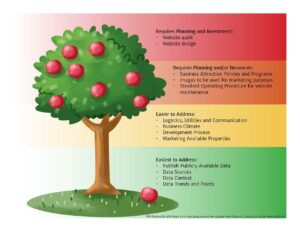Research has shown that there is a positive correlation[1] between diversity and business performance.[2] Diverse talent provides a broader understanding of customer needs, desires, and increases innovation. Finally, it improves the quality of decision-making, employee satisfaction, and improves the company’s global image. (For a deeper dive into workplace diversity see our July 21, 2020 blog post. Creating an inclusive culture, however, takes work.
While many desire to attract diverse talent, that talent may be put-off when they do not see examples of themselves represented at the company or in the community. It is a bit of the “chicken or the egg” scenario. Therefore, communities struggling to attract diverse residents may want to conduct an assessment of their community’s culture. A community’s culture is the synthesis of its values. These values are in the fabric of who they are and communicated through its mission, vision, strategies, events, and services. For example, the University of Wisconsin-Madison has a process of helping students absorb the Wisconsin Idea. At first, overtly through new student presentations and then more subtly by observing the services professors provide communities.
The Wisconsin Idea
One of the longest and deepest traditions surrounding the University of Wisconsin, the Wisconsin Idea signifies a general principle: that education should influence people’s lives beyond the boundaries of the classroom. Synonymous with Wisconsin for more than a century, this “Idea” has become the guiding philosophy of university outreach efforts in Wisconsin and throughout the world…
https://www.wisc.edu/wisconsin-idea/
Community Assessment
So how will your community welcome potential employee recruits? Will they be asked to contribute or lead? Will elected officials and City Staff invite them to connect with other new residents and themselves? (As economic development professionals this is a ripe opportunity to potentially cultivate your economic garden by developing relationships with potential entrepreneurs.)
Additionally, what labels do newcomers bear that distinguish them from the rest of the community? For example, Been Here may refer to those that have lived in the community for a while or generations of families, while Got Here may refer to those who recently moved (even if it was 20 years ago). In one community I worked in, the City Manager had lived there for a couple of years and became an honorary [Community]-an. Some members of the community were upset because they took that title seriously and only applied it to those who had grown up there.
Culture Starts with Leadership
The development of the community culture begins with the leadership. One strategy is to form a formal committee with stakeholders from multiple disciplines, ages, and representatives of various protected classes. This would provide a forum for a continual dialog regarding the issues of the day, housing development needs, etc. This commission may develop metrics for strategically evaluating progress, provide input for programs and policies to the governing board, and educate constituents about the collective decision-making process. The City of Elk Grove in California and City of Warrensburg, MO are a couple of examples.
Such a committee should have a specific role and set of goals for the community. Examples of roles and goals a committee could pursue include:
- Educating the public about community initiatives
- Collaborative decision making and/or mediating for community issues that present competing priorities
- Acting as an organizing body or collaborator for various efforts throughout the community
- Holding municipality/community accountable to its goals
Another strategy is to educate community leadership on the economic benefits of diverse voices in their communities. I recently heard a story of a business couple that was moving back to their previous community, because while they were active in the community they were still considered “other.” Unfortunately, that community lost an economic asset and diverse talent.
If diversity is a community value, an assessment of how the community is exemplifying that value should be conducted. In the podcast Pathways to Rural Prosperity, Don Macke and his guests discuss their experience and observations of thriving rural communities which includes inclusivity, leadership and strategy.
[1] Note: Correlation means that two things are related, however, it is unclear whether one causes the other.
[2] Herring, Cedric. Is Diversity Still a Good Thing?. 82 American Sociological Review. 868, 871
Photo by HiveBoxx on Unsplash.






